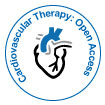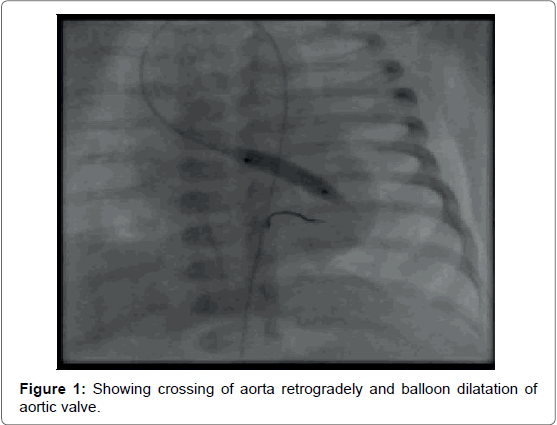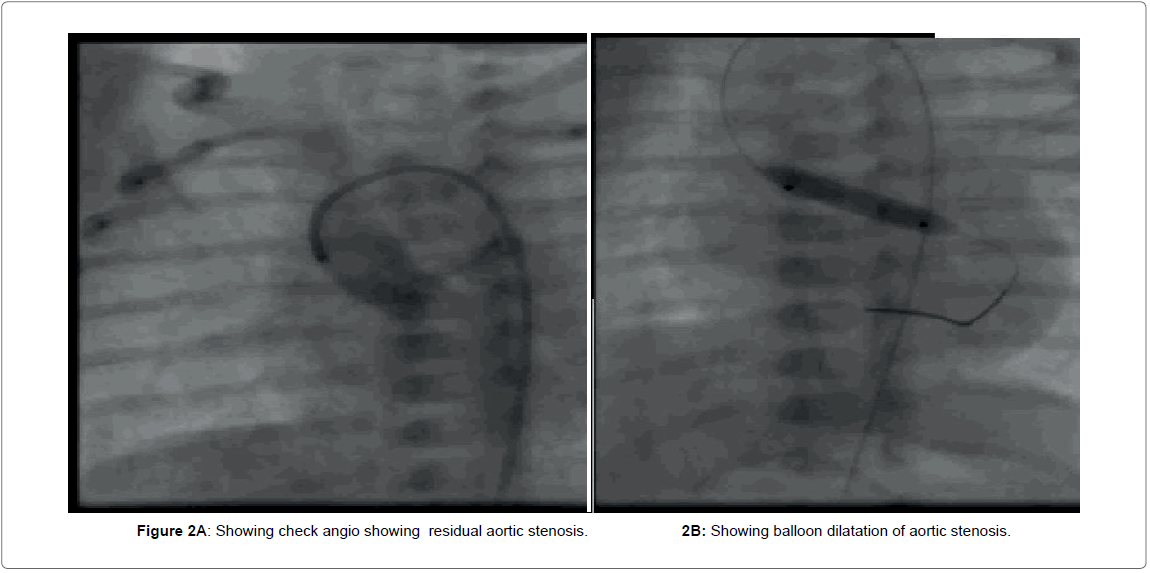A Rare Case of Retrograde Aortic Balloon Valvuloplasty in a Neonate with LV Dysfunction
Received: 23-Mar-2016 / Accepted Date: 06-May-2016 / Published Date: 13-May-2016
Abstract
Severe valvular aortic stenosis (AS) is one of the congenital heart defects that may require intervention during neonatal period. Balloon aortic valvuloplasty has become in many centre’s the treatment of choice for neonates with critical or severe aortic stenosis. Usual approaches both ante grade and retrograde can be problematic in neonates. Despite the availability of the balloon valvotomy technology, experience with balloon aortic valvotomy has been limited to older children with valvular AS. We report the successful application of BAV in a neonate with severe valvular AS.
Keywords: Retrograde; Aortic; Balloon valvuloplasty; Neonate
77971Case Report
A 25 day old male neonate presented to our institution with excessive sweating during feeds since few days after birth. On examination the neonate appeared weak with decreased feeding (Weight 2.8 kg). He was tachypneic with feeble pulses. There was no hepatomegaly. Cardiovascular examination revealed cardiomegaly, vulvar ejection click and an ejection systolic murmur of aortic stenosis. Left ventricular hypertrophy was recorded in the ECG and the chest X-ray showed cardiac enlargement. Two dimensional echocardiography revealed an enlarged hypertrophied left ventricle with reduced left ventricular function and a tricuspid aortic valve with systolic doming. A gradient of 102 mm Hg was recorded on Doppler examination.
After obtaining informed written consent for BAV the recorded baseline hemodynamic data suggested severe valvular AS with an aortic valve gradient of 108 mg Hg. We dilated the aortic valve using a 10 mm balloon (annulus size 10 mm) mounted on a 5 French catheter passed percutaneous via the right femoral artery (Figures 1 and 2). The result gradient across the aortic valve was 54 mm Hg. The procedure was uneventful except for transient ectopic during balloon dilatations. At the time of discharge the infant was feeding well without head sweats. Short term fallow up revealed favourable outcome.
Discussion
The optimal management for critical aortic stenosis in early infancy continues to challenge cardiologists and cardiac surgeons [1]. Trans catheter aortic balloon valvuloplasty has become the first-line treatment for critical aortic stenosis (AS) in neonates. However, need to know more about the growth and function of left heart structures or about patterns of re-intervention on the left heart after neonatal aortic balloon valvuloplasty [2].
Aortic balloon valvuloplasty offeres effective short and medium term palliation. Balloon valvuloplasty patients have more re intervention rates but shorter hospital and intensive care stay, reduced immediate morbidity and are associated with less severe aortic regurgitation [3]. The indication for Aortic balloon valvuloplasty according to AHA/ ACC guidelines is a cath systolic gradient >60 mmHg or >50 mmHg cath gradient in patient with symptoms. Literatures indicate that the procedure results in an acute reduction in gradient ranging from 49%- 70% as in our case, and this reduction appears to persist through at least an intermediate follow-up. The percentage reduction in gradient is similar for neonates as well as older children [4].
In neonates, it is imperative to evaluate the size of the left ventricle prior to balloon valvuloplasty since mortality is highest in those with variants of hypo plastic left heart syndrome. Though morbidity and mortality is higher in the neonatal age group, the results are similar to those following surgical intervention [4]. In children older than 1 month of age, the major complication is the development of aortic regurgitation, although it usually appears to be well-tolerated [4].
Previous surgical valvotomy is not a contraindication to balloon aortic valvuloplasty. Mortality associated with aortic balloon valvuloplasty has significantly reduced with availability of small sized hardware’s and balloons reducing the immediate post procedural complications. Previous predictors of mortality included young age at presentation [5].
Patients with critical aortic stenosis, who require balloon dilatation within the first month of life, but especially within the first week, have a poorer outcome than those requiring the procedure later, and this can be accounted for by a tendency toward less favourable anatomical features. Small left heart structures may be associated with poor subacute outcomes but typically normalize within 1 year. But aortic valve replacement during early childhood is seldom necessary [4]. In the current times, we believe that balloon aortic valvuloplasty should be considered as the first option in neonates, children and young adults with severe aortic valve stenosis.1 late prognosis depends on the quality of the left heart structures [6-9].
Conclusion
Surgical aortic valvotomy in neonates and infants is associated with high morbidity and mortality. Aortic balloon valvotomy is an attractive alternative and produces comparable results. Balloon aortic valvuloplasty is a safe and effective treatment for aortic stenosis in neonates and infants.
References
- Vida VL, Bottio T, Milanesi O, Reffo E, Biffanti R, et al. (2005) Critical aortic stenosis in early infancy: surgical treatment for residual lesions after balloon dilation. Annals Thorac Surg 79: 47-51.
- McElhinney DB, Lock JE, Keane JF, Moran AM, Colan SD, et al. (2005) Left heart growth, function, and reintervention after balloon aortic valvuloplasty for neonatal aortic stenosis. Circulation 111: 451-458.
- Zain Z, Zadinello M, Menahem S, Brizard C (2006) Neonatal isolated critical aortic valve stenosis: balloon valvuloplasty or surgical valvotomy. Heart Lung Circ 15: 18-23.
- Sandhu SK, Silka MJ, Reller MD (1995) Balloon aortic valvuloplasty for aortic stenosis in neonates, children, and young adults. J Intervene Cardiol 8: 477-486.
- Latiff HA, Sholler GF, Cooper S (2003) Balloon dilatation of aortic stenosis in infants younger than 6 months of age: intermediate outcome. Pediatric Cardiol 24: 17-26.
- Kasten-Sportes CH, Piechaud JF, Sidi D, Kachaner J (1989) Percutaneous balloon valvuloplasty in neonates with critical aortic stenosis. J Am Coll Cordial 13: 1101-1105.
- Hawkins JA, Minich LL, Tani LY, Day RW, Judd VE, et al. (1998) Late results and reintervention after aortic valvotomy for critical aortic stenosis in neonates and infants. Annals of Thorac Surg 65: 1758-1762.
- Beekman RH, Rocchini AP, Andes A (1991) Balloon valvuloplasty for critical aortic stenosis in the newborn: Influence of new catheter technology. J Am Coll Cardiol 17: 1172-1176.
- Malcic I, Saric D, Dasovic-Buljevic A, Disessa T, Uhlemann F, et al. (2005) Transluminal balloon valvuloplasty in neonates and infants with critical aortic stenosis. Lijecviesn 127: 279-284.
Citation: Natesh BH, Dharmendra VG, Vijayalakshmi IB and Manjunath CN (2016) A Rare Case of Retrograde Aortic Balloon Valvuloplasty in a Neonate with LV Dysfunction. Cardiovasc Ther 1: 106.
Copyright: © 2016 Natesh BH, et al. This is an open-access article distributed under the terms of the Creative Commons Attribution License, which permits unrestricted use, distribution, and reproduction in any medium, provided the original author and source are credited.
Select your language of interest to view the total content in your interested language
Share This Article
Open Access Journals
Article Usage
- Total views: 11828
- [From(publication date): 6-2016 - Jul 01, 2025]
- Breakdown by view type
- HTML page views: 10907
- PDF downloads: 921


